Superoxide Dismutase (SOD) Activity Assay Kit
Note: It is necessary to predict 2-3 large difference samples before the formal determination.
Operation Equipment: Spectrophotometer
Cat No: BC0170
Size: 50T/24S
Components:
Extraction reagent: 60 mL×1. Storage at 4℃.
Reagent Ⅰ: 15 mL×1. Storage at 4℃.
Reagent Ⅱ: 160 μL×1. Storage at 4℃. Mix by pipetting after centrifugation.
Reagent Ⅲ: 11 mL×1. Storage at 4℃.
Reagent Ⅳ: Powder×1. Storage at 4℃.
Reagent V: 2 mL×1. Storage at 4℃. Add Reagent Ⅳ to Reagent V before use and shake with an oscillator to mix thoroughly. It can be stored 3 months.
Product Description:
Superoxide dismutase (SOD, EC 1.15.1.1) is widely found in animals, plants, microorganisms and cultured cells. It catalyzes the superoxide anion to form H2O2 and O2. SOD is not only the superoxide anion scavenging enzyme, but also the main H2O2 producing enzyme, which plays an important role in the biological antioxidant system.
Superoxide anion (O2-) is produced by the xanthine and xanthine oxidase reaction system. O2- can reduce blue tetrazole to create blue formazan, which has absorbance in 560 nm. SOD can remove O2- and inhibit the formation of methionine. The darker the blue color of the reaction solution, the lower the activity of SOD. The lighter the blue color of the reaction solution, the higher the activity of SOD.
Reagents and Equipment Required but Not Provided:
Spectrophotometer, table centrifuge, transfer pipette, 1 mL glass cuvette, mortar/homogenizer, ice and distilled water.
Operation steps:
I. Sample preparation:
- Bacteria or cells: collecting bacteria or cells into the centrifuge tube, discard supernatant after centrifugation. According to the proportion of bacteria or cells (104 cells): extraction solution volume (mL) of 1:5-10 to extract. It is suggested that 5 million of bacteria or cells amount with 1mL of Extraction reagent. Splitting the bacteria or cells with ultrasonication (placed on ice, ultrasonic power 200W or 20%, working time 3s, interval 10s, repeat for 30 times). Centrifuge at 8000 ×g for 10 minutes at 4℃ to remove insoluble materials, and take the supernatant on ice before testing.
- Tissue: according to the proportion of tissue weight (g): extraction solution volume (mL) of 1:5-10 to extract. It is suggested that 0.1 g of tissue with 1 mL of Extraction reagent and fully homogenized on ice.
- Centrifuge at, 8000 ×g for 10 minutes at 4℃ to remove insoluble materials, and take the supernatant on ice before testing.
- Serum (plasma) sample: detect sample directly.
II. Determination procedure:
- Preheat the spectrophotometer for 30 minutes, adjust wavelength to 560 nm and set zero with distilled water.
- Keep Reagent Ⅰ, Reagent Ⅲ, Reagent V in water bath for more than 5 minutes at 37℃(mammal) or
25℃ (other species).
- Add reagents with the following list:
| Reagent (μL) | Test tube (T) | Control tube (C) | Blank tube (B1) | Blank tube (B2) |
| Sample | 90 | 90 | – | – |
| Reagent Ⅰ | 240 | 240 | 240 | 240 |
| Reagent Ⅱ | 6 | – | 6 | – |
| Reagent Ⅲ | 180 | 180 | 180 | 180 |
| Distilled water | 480 | 486 | 570 | 576 |
| Reagent V | 30 | 30 | 30 | 30 |
Mix thoroughly and the mixture is incubated at room temperature for 30 minutes. Add the mixture into 1mL glass cuvette, and detect the absorbance value of each tube at 560 nm. ΔAT=AT-AC,ΔAB=AB1-AB2. If there is precipitation at the bottom, mix thoroughly and then measure.
III. Calculation:
- Inhibition percentage:
Inhibition percentage=[ΔAB -ΔAT]÷ΔAB× 100%
The inhibition percentage should be in 30%~70% (the value close to 50% will have a more accurate result). If the calculated inhibition percentage is less than 30% or more than 70%, it is usually necessary to adjust the sample addition amount and re determine. If the percentage of inhibition is too high, the sample should be diluted properly. If the percentage of inhibition is too low, the sample should be reprepared with a higher concentration.
- Unit definition: One unit of enzyme activity is defined as the amount of enzyme catalyzes the inhibition of 50% in the reaction system of the above xanthine
- Calculation
A. Serum (plasma)sample
SOD (U/mL)=[P÷(1-P)×Vrv]÷Vs×F=11.4×P÷(1-P)×F
B. Tissue, bacteria or cultured cells
a) Protein concentration:
SOD (U/mL prot) = [P÷(1-P)×Vrv]÷(Vs×Cpr)×F=11.4×P÷(1-P)÷Cpr×F
b) Sample weight
SOD (U/g weight) = [P÷(1-P)×Vrv]÷(W×Vs÷Vsv)×F=11.4×P÷(1-P)÷W×F
c) Bacteria or cell amount
SOD (U/104 cell)=[P÷(1-P)×Vrv]÷(500×Vs÷Vsv)×F=0.0228×P÷(1-P)×F
Vrv: Total reaction volume, 1.026 mL; Vs: Sample volume, 0.09 mL;
Vsv: Extraction volume, 1 mL;
Cpr: Sample protein concentration, mg/mL; W: Sample weight, g;
500: Total number of bacteria and cells, 5 million. P: Inhibition percentage, %;
F: Sample dilution multiple.
Note:
- The Sample and Reagent Ⅱ should be placed on ice when
- When there are many samples, the working solution (including Reagent I, II and III) can be configured according to the table. Reagent V must be added
- After the reaction completed, there may be precipitation formed, which can be determined after
Experimental Examples:
- 1 g of Echinochloa crusgalli is added into 1 mL of Extraction reagent for homogenization. After the supernatant is taken, the operation is carried out according to the determination steps. The results showed that ΔAT = AT – AC = 0.335-0.012 = 0.323, ΔAB = AB1 – AB2 = 0.957-0.003 = 0.954. Inhibition percentage = (ΔAB- ΔAT)÷ ΔAB × 100% = 72%, and the enzyme activity is calculated according to the sample mass.
SOD activity (U/g mass) = 11.4 × Inhibition percentage (1-Inhibition percentage) × W = 293.14 U/g mass.
- 1 mL of Extraction reagent is added to 0.1 g of rat spleen for homogenization. After the supernatant is taken, the operation is carried out according to the determination steps. The results showed that ΔAT= AT- AC = 0.563-0.213 = 0.35, ΔAB= AB1- AB2= 0.957-0.003 = 0.954, inhibition percentage = (ΔAB -ΔAT)÷ ΔAB×100% =31%
SOD activity (U/g mass) = 11.4 × Inhibition percentage (1-Inhibition percentage) ×W = 196.71 U/g mass.
- 10 million cells is extracted and centrifuged by adding 1 mL of Extraction reagent, and then the operation is performed according to the determination steps. The results are as follows: ΔAT =AT – AC=614-0.015 = 0.599, ΔAB= AB1- AB2= 0.944-0.005 = 0.939, inhibition percentage = (ΔAB- ΔAT) ×ΔAB× 100% = 36.21%
SOD activity (U/104 cell) = Inhibition percentage ÷ (1-Inhibition percentage)× VTS]÷(1000× VS ÷ VTS) = 0.0065 U/104 cell.
References:
- Spitz D R, Oberley L W. An assay for superoxide dismutase activity in mammalian tissue homogenates[J]. Analytical Biochemistry, 1989,179(1):8-18.
- Masayasu M, Hiroshi Y. A simplified assay method of superoxide dismutase activity for clinical use[J]. Clinica Chimica Acta, 1979,92(3):337-342.
Related Products:
BC0190/BC0195 Polyphenol Oxidase (PPO) Activity Assay Kit
BC0210/BC0215 Phenylalnine Ammonialyase (PAL) Activity Assay Kit
BC0200/BC0205 Catalase (CAT) Activity Assay Kit
BC0090/BC0095 Peroxidase (POD) Activity Assay Kit
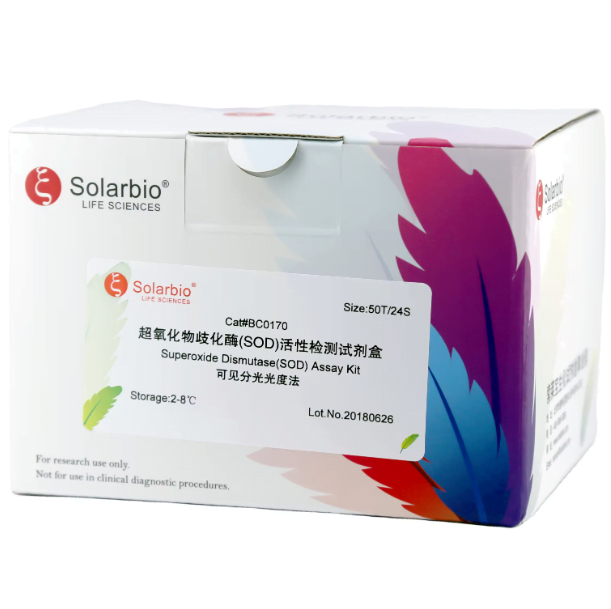
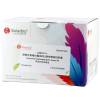
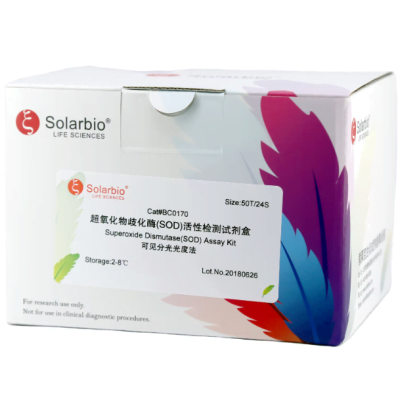
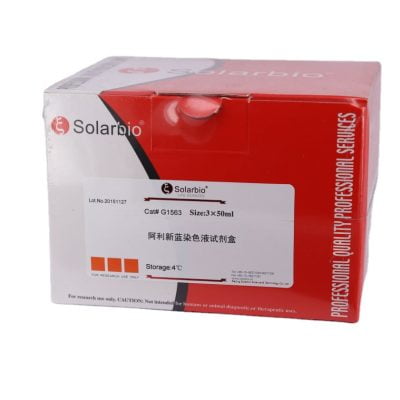
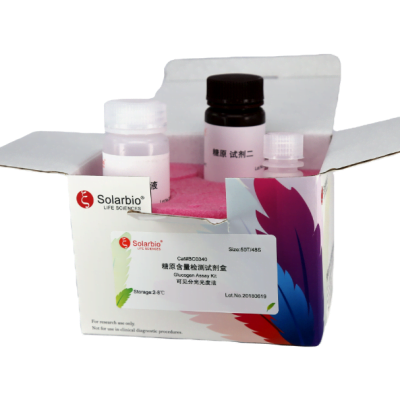
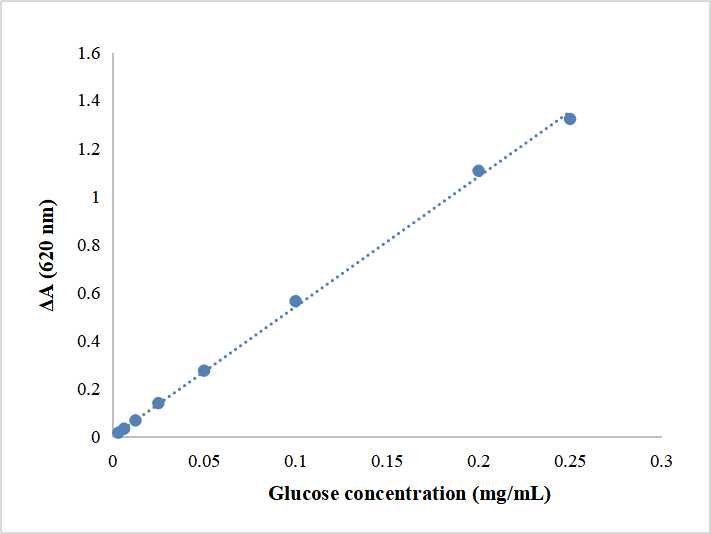
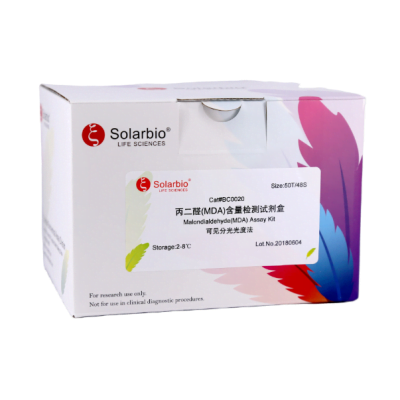
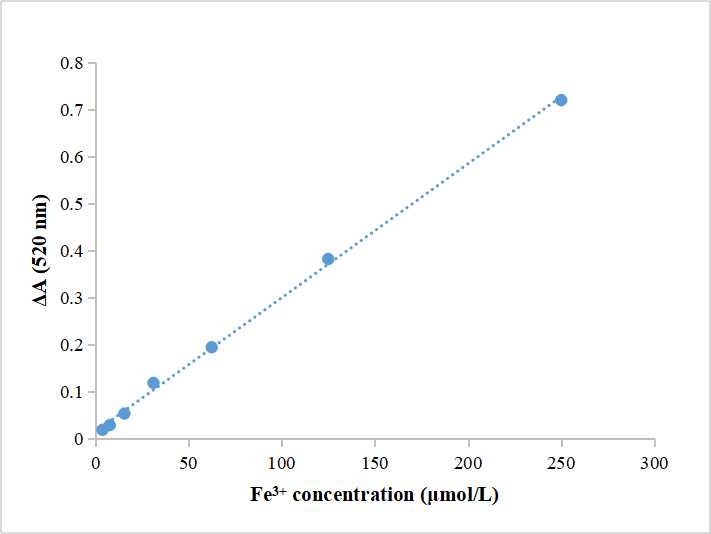
Reviews
There are no reviews yet.